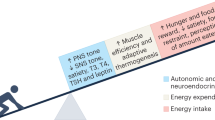Abstract
Many dieters experience years of yo-yo weight fluctuation. Typically, the yo-yo effect is described as being able to lose weight on a diet but invariably, the lost weight is regained in the long-term. The weight set-point theory explains these dietary failures by hypothesizing that each individual has a weight setting which is determined by a combination of genetic, epigenetic, and environmental factors. When an individual’s weight diverges from the set-point, a biological homeostatic response occurs. Changes in appetite, satiety, and basal metabolic rate occur to defend the set-point weight. Powerful fluctuations occur in the expenditure of basal metabolic energy via the autonomic nervous system.
Similar content being viewed by others
References
World Health Organization. Obesity 2008.
Speakman JR, Levitsky DA, Allison DB, Bray MS, de Castro JM, Clegg DJ, et al. Set points, settling points and some alternative models: theoretical options to understand how genes and environments combine to regulate body adiposity. Dis Model Mech. 2011;4(6):733–45. https://doi.org/10.1242/dmm.008698.
Dulloo AG, Girardier L. Adaptive changes in energy expenditure during refeeding following low-calorie intake: evidence for a specific metabolic component favoring fat storage. Am J Clin Nutr. 1990;52(3):415–20. https://doi.org/10.1093/ajcn/52.3.415.
Hill JO. Body weight regulation in obese and obese-reduced rats. Int J Obes. 1990;14(Suppl 1):31–47.
Keys A, Brožek J, Henschel A, Mickelsen O, Taylor HL. The Biology of Human Starvation: Volume II. St. Paul, MN: University of Minnesota Press; 1950. 632 p. Available from: https://www.jstor.org/stable/10.5749/j.cttttqzj
Sims EA, Horton ES. Endocrine and metabolic adaptation to obesity and starvation. Am J Clin Nutr. 1968;21(12):1455–70. https://doi.org/10.1093/ajcn/21.12.1455.
Pasquet P, Apfelbaum M. Recovery of initial body weight and composition after long-term massive overfeeding in men. Am J Clin Nutr. 1994;60(6):861–3. https://doi.org/10.1093/ajcn/60.6.861.
Prentice AM, Jebb SA, Goldberg GR, Coward WA, Murgatroyd PR, Poppitt SD, et al. Effects of weight cycling on body composition, Am J Clin Nutr. 1992;56(1 Suppl):209S–16S. https://doi.org/10.1093/ajcn/56.1.209S.
Arone LJ, Mackintosh R, Rosenbaum M, Leibel RL, Hirsch J. Autonomic nervous system activity in weight gain and weight loss. Am J Physiol. 1995;269(1 Pt 2):R222–5. https://doi.org/10.1152/ajpregu.1995.269.1.R222.
Fothergill E, Guo J, Howard L, Kerns JC, Knuth ND, Brychta R, et al. Persistent metabolic adaptation 6 years after “The Biggest Loser” competition. Obesity (Silver Spring). 2016;24(8):1612–9. https://doi.org/10.1002/oby.21538.
Harris AM, Jensen MD, Levine JA. Weekly changes in basal metabolic rate with eight weeks of overfeeding. Obesity (Silver Spring). 2006;14(4):690–5. https://doi.org/10.1038/oby.2006.78.
Speakman JR, Krol E, Johnson MS. The functional significance of individual variation in basal metabolic rate. Physiol Biochem Zool. 2004;77(6):900–15. https://doi.org/10.1086/427059.
Giralt M, et al. Mitochondrial uncoupling and the regulation of glucose homeostasis. Diabetes Rev. 2017;13(4):386–94.
Pant M, Bal NC, Periasamy M. Sarcolipin: a key thermogenic and metabolic regulator in skeletal muscle. Trends Endocrinol Metab. 2016;27(12):881–92.
Bal NC, Sahoo SK, Maurya SK, Periasamy M. The role of sarcolipin in muscle non-shivering thermogenesis. Front Physiol. 2018;9:1217. https://doi.org/10.3389/fphys.2018.01217.
Karra E, Batterham RL. The role of gut hormones in the regulation of body weight and energy homeostasis. Mol Cell Endocrinol. 2010;316(2):120–8. https://doi.org/10.1016/j.mce.2009.06.010.
Bailey R. Evaluating Calorie Intake for Population Statistical Estimates (ECLIPSE) [Internet]. 2018. Office for National Statistics, Data Science Campus; 2017 Apr 15 [cited 2018 FEB 15]. Available from: https://datasciencecampus.ons.gov.uk/evaluating-calorie-intake-for-population-statistical-estimates-eclipse/.
Wardle J, et al. Evidence for a strong genetic influence on childhood adiposity despite the force of the obesogenic environment. Am J Clin Nutr. 2008;87(2):398–404.
Stein Z, Susser M. The Dutch famine, 1944–1945, and the reproductive process. I. Effects on six indices at birth. Pediatr Res. 1975;9(2):70–6. https://doi.org/10.1203/00006450-197502000-00003.
Hult M, Tornhammar P, Ueda P, Chima C, Edstedt Bonamy AK, Ozumba B, et al. Hypertension, diabetes and overweight: looming legacies of the Biafran famine. PLoS One. 2010;5(10):e13582. https://doi.org/10.1371/journal.pone.0013582.
Guénard F, Deshaies Y, Cianflone K, Kral JG, Marceau P, Vohl M-C. Differential methylation in glucoregulatory genes of offspring born before vs. after maternal gastrointestinal bypass surgery. Proc Natl Acad U S A. 2013;110(28):11439–44. https://doi.org/10.1073/pnas.1216959110.
Simopoulos AP. An increase in the omega-6/omega-3 fatty acid ratio increases the risk for obesity. Nutrients. 2016;8(3):128. https://doi.org/10.3390/nu8030128.
Kopp W. How Western diet and lifestyle drive the pandemic of obesity and civilization diseases. Diabetes Metab Syndr Obes. 2019;12:2221–36. https://doi.org/10.2147/DMSO.S216791.
Jenkinson A. Why we eat (too much) – the new science of appetite. Published by Penguin; 2020.
Dankel SN, Degerud EM, Borkowski K, Fjære E, Midtbø LK, Haugen C, et al. Weight cycling promotes fat gain and altered clock gene expression in adipose tissue in C57BL/6J mice. Am J Physiol Endocrinol Metab. 2014;306(2):E210–24. https://doi.org/10.1152/ajpendo.00188.2013.
Rosenbaum M, Leibel RL. 20 years of leptin: role of leptin in energy homeostasis in humans. J Endocrinol. 2014;223(1):T83–96. https://doi.org/10.1530/JOE-14-0358.
Kelesidis T, et al. Narrative review: the role of leptin in human physiology: emerging clinical applications. Ann Int Med. 2010;152(2):93–100.
Lustig RH, Sen S, Soberman JE, Velasquez-Mieyer PA. Obesity, leptin resistance, and the effects of insulin reduction. Int J Obes Relat Metab Disord. 2004;28(10):1344–8. https://doi.org/10.1038/sj.ijo.0802753.
Wisse BE, Schwartz MW. Does hypothalamic inflammation cause obesity? Cell Metab. 2009;10(4):241–2. https://doi.org/10.1016/j.cmet.2009.09.003.
Nieto-Vazquez I, Fernández-Veledo S, Krämer DK, Vila-Bedmar R, Garcia-Guerra L, Lorenzo M. Insulin resistance associated to obesity: the link TNF-alpha. Arch Physiol Biochem. 2008;(3):183–94. https://doi.org/10.1080/13813450802181047. Erratum in: Arch Physiol Biochem. 2009;115(2):117.
Simopoulos AP. Omega-6/omega-3 essential fatty acid ratio and chronic diseases. Food Rev Int. 2004;20(1):77–90. https://doi.org/10.1081/FRI-120028831.
Author information
Authors and Affiliations
Editor information
Editors and Affiliations
Section Editor information
Rights and permissions
Copyright information
© 2021 Springer Nature Switzerland AG
About this entry
Cite this entry
Jenkinson, A. (2021). Why Sustained Dietary Weight Loss Is So Difficult. In: Agrawal, S. (eds) Obesity, Bariatric and Metabolic Surgery. Springer, Cham. https://doi.org/10.1007/978-3-030-54064-7_112-1
Download citation
DOI: https://doi.org/10.1007/978-3-030-54064-7_112-1
Received:
Accepted:
Published:
Publisher Name: Springer, Cham
Print ISBN: 978-3-030-54064-7
Online ISBN: 978-3-030-54064-7
eBook Packages: MedicineMedicine




